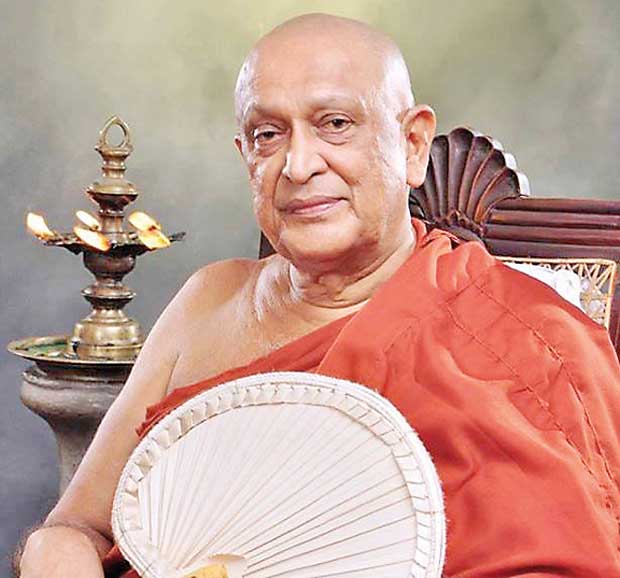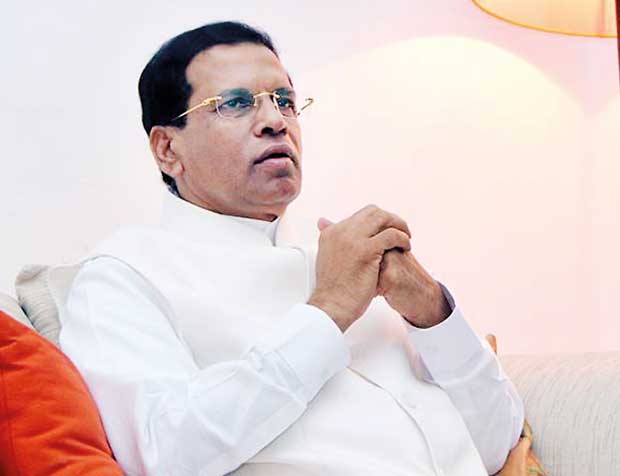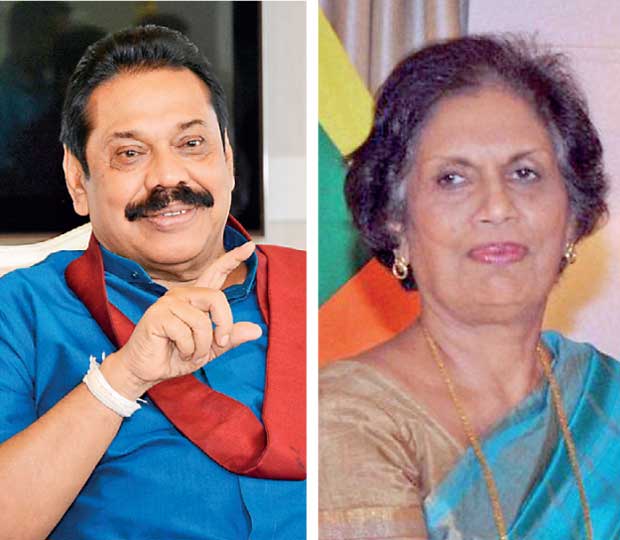Reply To:
Name - Reply Comment
Last Updated : 2024-04-19 18:04:00


A wide spectrum representing civil and political society – politicians, religious dignitaries, academics, artists, professionals, media persons, trade unionists, civil society activists and students- voted for the Common Candidate on one main issue, namely, the abolition of the executive presidency based on appeals by Ven. Maduluwawe Sobitha thero of National Movement for Social Justice (NMSJ), who sought a return to parliamentary form of government.
At the end of his second term in end 1988, JR was toying with the idea of using his 5/6 in a third attempt; he used two of his lieutenants to go public ‘demanding the boss to consider their earnest request’, but was compelled to drop the idea considering negative intelligent reports based on 88/89 terror period which marked killings of civilians, destruction of national assets and unspeakable atrocities committed against humanity - in one of nation’s darkest phases . The people identified not only the muttiya, but the hand that pushed it.
CBK, sans a 2/3 majority had a desire in mid 2004, of extending her term as an ‘executive prime  minister’ with or without a referendum in early 2005. Tsunami, the immense natural disaster that killed over 30,000 people and displaced nearly 500,000, created a deep psychological impact. P-TOMS followed destroying her ambitious schemes. Mahinda, who was brimming with confidence was successful in pushing through the legislature the necessary amendments but the voter had other ideas.
minister’ with or without a referendum in early 2005. Tsunami, the immense natural disaster that killed over 30,000 people and displaced nearly 500,000, created a deep psychological impact. P-TOMS followed destroying her ambitious schemes. Mahinda, who was brimming with confidence was successful in pushing through the legislature the necessary amendments but the voter had other ideas.
The SLFP, in a recent move is toying with the idea of making President Sirisena contest in 2020. Some senior ministers and Sirisena loyalists have, at media shows, said the party CC wished him to enter the fray, they continued, “…he has to abide by the party decision.”
Junius Richard Jayewardene, the architect of Executive Presidency was asked what he thought on CBK’s pledge to JVP in November 1994, assuring the abolition of Executive Presidency, the ‘old fox’ described the promise a faux pas. In the past, abolition of Executive Presidency has been soberly undertaken prior to elections by every prospective candidate and manifestly discarded afterwards. CBK made a pledge in writing to JVP assuring the abolition of Executive Presidency before 15th July 1995. Janatha Vimukthi Peramuna withdrew its presidential contender to ensure her victory. ‘Ingenuous lady’ Chandrika Bandaranaike Kumaratunga, the daughter of two Prime Ministers, who succumbed to indigenous political wisdom not only remained in the position until the end of her six-year term, but had the audacity to backtrack on the promise and contest a second term as well. The gullible but compassionate Sri Lankans did cast a sympathy vote for the wounded lady who survived a terrorist bomber to be back in the ‘hot seat’ for a second term. However, CBK used all the Executive powers for two terms; she even misused her powers in numerous ways especially during her last two years in office.
At the 2005 November presidential elections Mahinda Rajapakse promised the abolition of Executive Presidency. MR went a step further; he not only disrespected the assurance he made to the people in his “chinthanaya”, but introduced 18th Amendment to the Constitution abolishing the clause preventing him from contesting a third term. He became answerable for the surfacing of the most fraudulent and corrupt ruling clan in our history. [prior to Jan 8]
Ranil Wickremesinghe with former LSSPer, Jayampathy Wickremeratne PC, drafted the 19th Amendment vesting all powers in the Prime Minister. The PM was to be the head of government, but the other stake holders did not agree to this move. Therefore they pruned down some powers of the President and left some behind.
“A strong executive seated in power for a specific period, not subject to the whims and fancies of an elected legislature will not be afraid of taking correct but unpopular decisions. This seems to me a very necessary requirement in a developing country faced with grave problems.”- JR as Minister of State.
“Constitutions are drafted by human societies in accordance with the circumstances of the time at which they were drawn up”- Dr. Colvin R. de Silva
The combined powers of both the legislative and the executive which fused into one distinct being in the 1978 Constitution - was a noteworthy change from the Westminster form that we have been following, which defined the ‘separation of powers’ of head of state known as President and head of government, the Prime Minister.

The cabinet on March 15, 2015 decided that the Presidency needs to be reformed on certain features, including the term limit back to two, period of presidency to five instead of six, and powers on the dissolution of parliament only after four and a half years. The Westminster system clearly says, the PM cannot take a particular decision without the approval of the cabinet, and then for parliament for a debate if the cabinet fails to pass it unanimously.
H. W. Jayewardene QC, the brother of JR, in 1978, created a characteristic and unparalleled executive presidency when he drafted the Constitution by merging both French and the United States Presidential systems. The Constitution of 1947 had the executive commands bestowed with the Governor-General who was chosen by the crown as its representative. The Cabinet, Judges of the Supreme Court and members of the Public Service Commission were appointed by the Governor-General on PM’s recommendations, a system that encouraged transparency, with restrictions for nepotism and partiality. Under the JR Constitution, the President was elected by people, therefore it was argued that vesting this power with an outside authority was a breach of people’s sovereignty. Three Schools of Thought
There are three schools of thought, all with divergent views on the Presidency; some wants to continue it in its present form; they think proper implementation of growth strategies can be more competently apprehended under an executive President. Second school professes total abolition, and a third believes in a few more amendments. The opponents of the executive presidential system would argue that there is a concentration of governmental power in a distinct individual at the expense of Parliamentarians, but even under the parliamentary system, the head of the state PM becomes a virtual autocrat with declaration of an emergency. The prospect of being held answerable will prevent the Executive President from being disrespectful of the law of the land. Further there are provisions for the impeachment of the Executive President while in office; of course, under specific criteria.
Maithripala Sirisena never said in his manifesto that he would abolish the Executive Presidency altogether. Let me quote directly from Maithri’s manifesto, “The new Constitutional structure would be essentially an Executive allied with the Parliament through the Cabinet instead of the present autocratic Executive Presidential System. Under it the President would be equal with all other citizen before the law. I guarantee that in the proposed Constitutional Amendment I will not touch any Constitutional Article that could be changed only with the approval at a Referendum. I also ensure that I will not undertake any amendment that is detrimental to the stability, security and sovereignty of the country. My Amendments will be only those that facilitate the stability, security and sovereignty of the country.”
President Maithripala Sirisena promised to implement a 100-day reconstruction programme where he pledged to restructure the executive branch within 100 days if elected, by strengthening the judiciary and parliament, to fight against corruption and to investigate allegations of war crimes, repeal the 18th Amendment etc,.
‘An ideal executive must be both stable as well as responsible to the people who elected it.’- Ambedkar
The reality has been that anybody elected to that all-powerful position having powers to do anything but change man into woman and vice versa will be averse or unable to renounce those powers.
However, the President who kept mum on the issue should not give lame excuses to the people quoting his party’s CC - and if the SLFP is unable or not willing to stick to the pledge they had made before January 8, then they should go before the people for them to decide.
‘They choose once in five years who shall oppress them for the next five years’! ; said, Karl Marx

Add comment
Comments will be edited (grammar, spelling and slang) and authorized at the discretion of Daily Mirror online. The website also has the right not to publish selected comments.
Reply To:
Name - Reply Comment
On March 26, a couple arriving from Thailand was arrested with 88 live animal
According to villagers from Naula-Moragolla out of 105 families 80 can afford
Is the situation in Sri Lanka so grim that locals harbour hope that they coul
A recent post on social media revealed that three purple-faced langurs near t